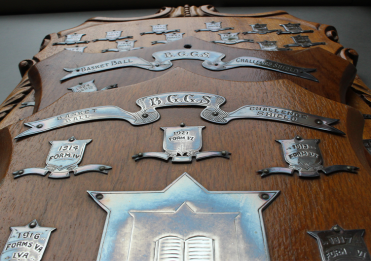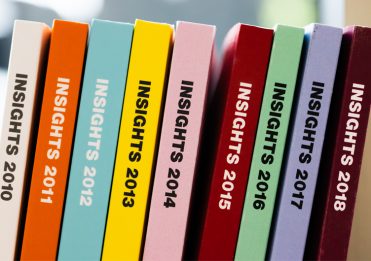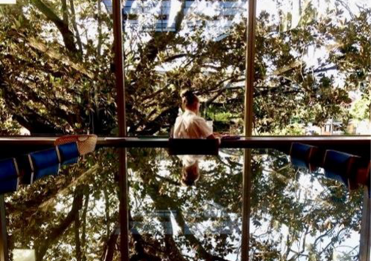Any book with ‘Property of the Trustees’ included in its title and referred to as The Confidential Book is daunting; however, when it is accompanied by a lock and key, it is really confronting!
The Archive collection has two elegant, leather-bound books with similar titles. What do they hold? Is it the Trustees’ Minutes, the School’s financial records, politically explosive information? Close scrutiny reveals they contain the thoughts and assessments made by the Inspector of Schools, an appointee of the Board of General Education, and responses to these evaluations and judgements by the Brisbane Girls Grammar School Headmistresses. So, perhaps, politically explosive material!
The concept of Inspector of Schools was an educational mechanism of quality control introduced in England during Queen Victoria’s reign in 1839. The inspectors were referred to as Her Majesty’s Inspectors of Schools (HMIs). The practice was adopted in New South Wales in 1854 and then across Australia, though not carrying the ‘grand appellation of Her Majesty’s Inspectors’.
Geoffrey Swan said in his thesis (2014, p.19):
In 1854, the colony of NSW appointed Australia’s first Inspector of Schools, William Wilkins. Soon after separating from NSW on 10 December 1859, Queensland received its first Inspector of Schools, Randal MacDonnell, an Irishman trained at the National School in Dublin.
Queensland’s Grammar schools were exposed to this scrutiny to check that standards were maintained. It stands to reason that the influential men of the newly separated state, such as Sir Charles Lilley and Sir Samuel Griffith, also took responsibility for Queensland’s educational standards and, no doubt, took particular interest in Girls Grammar, as both were Trustees of the School.
By the time the Girls Grammar ‘branch’ opened its doors in 1875, the Department of Public Instruction was established and, with it, education became a ‘ministerial responsibility’ (Swan, 2014).
Each Inspector worked with a standardised form with the following criteria: 1. Records; 2. Government; 3. Organisation; 4. Methods; 5. Proficiency and Progress of Pupils; 6. Care of Grounds; 7. School Games and Physical Exercises; 8. General Condition; and 9. General Remarks. Each criterion was addressed in the report to which the Headmistress responded, and the Trustees evaluated.

Detail of the proforma of the Inspector’s report
The Confidential Books date from 1910 to 1958 collectively. During this expanse of time, the School was challenged by a range of Inspectors’ opinions, Headmistresses’ responses, and Trustees’ stewardship. Interestingly, the early years of 1910 to 1919 saw Mr Reginald Roe, past Headmaster of Brisbane Grammar School, inspecting the girls’ curricula, performance, and general organisation.

1909 Reginald Heber Roe
The 1910–1912 Confidential Book was briefly and sparsely used. Hence the book retains an unbroken lock and key. The 1910 report poses an interesting question. The first four pages are carefully ruled into columns and, in elegant script, state: the name of the staff member; joined staff; salary; ‘increased’ (stating any increase or decrease in salary where applicable); subjects; time unoccupied (Mrs Burke and the Music Mistress, listed as none!); and remarks.

1912 Milisent Wilkinson
It is in the remarks column where the reader is mystified—as the column, which clearly was used, has been totally erased. Perhaps this was a mistake made by the Headmistress, Miss Milisent Wilkinson, pre-empting the Inspector’s report or a change in format. Whatever the reason, the 1911 report is in a format which then became the norm, where the Inspector’s report was either a carbon copy glued into the book or copied in beautiful cursive fountain pen with the Headmistress’ comments referring to specific elements of the report.

1910 pp2 and 4 erased remarks
The information in the first Confidential Book provides extraordinary insight into the staff employed at the School, their remuneration, and the curriculum taught. Teachers’ wages ranged from Miss Swanwick receiving 10 shillings a visit to teach bookkeeping, shorthand, typewriting, and V Form theory, to Miss Lothian receiving £200 per annum to teach Greek, Senior Latin, Ancient History, and part of Senior English. The Headmistress, Miss Wilkinson, received the princely sum of £500, which appears to be quite generous for the time.

1913 Miss Lothian with Miss Annie Mackay
The curriculum included English, Greek, Latin, French, German, Mathematics and Arithmetic, Physics, Botany, History (English and European), Ancient History, Geography, Physical Exercise, Gymnastics, Drawing and Painting, Music, Needlework, and commercial skills including bookkeeping and shorthand.
The 1911 Inspector, Mr Reginald Roe, delved deeply into this curriculum, highlighting issues ranging from Latin classes to the Gymnastics class.
‘In the highest form in revision work in all the language subjects, the teacher makes the mistake of doing all the talking, translating and telling the pupils again all the chief points instead of making the girls themselves reproduce and expand what has been given them before … The Gymnastic lesson of the Fourth class seemed rather weak. The proficiency of the girls was poor and the teacher did not appear to be alive to the importance of keeping all the girls going for most of the time’ (Confidential Book, 1910–12, pp 5 and 7).
The second Confidential Book spans from 1913 to 1958. It is a substantial and significant manuscript. This record’s importance cannot be underestimated. It explores the status of the School in Queensland, provides candid assessment of individuals, appraises the curriculum and its delivery, and challenges teaching methods and the effectiveness of these methods.
In these years we see the comments of five Headmistresses: Miss Mary Atkinson Williams; Miss Jane E Walker; Miss Annie Mackay; Miss Kathleen M Lilley; and Miss Louise Crooks. There were nine inspectors including Mr Roe and Mr John George who inspected the School 14 times.

1913-1958 Confidential Book p1
In 1913, Miss Atkinson Williams, newly appointed from Rockhampton Girls Grammar School, wrote a scathing report on the School stating: ‘I was frankly somewhat disappointed at the standard of work in the school’ and ‘the VIA is comparatively large, but only three girls have any real ability’ (Confidential Book 2, p.80). As Miss Mary Lilley was in this form, one hopes for Miss Williams’ sake, she was included in the three students with ability. Interestingly, Justice John Woolcock, chair of Trustees, wrote at the conclusion of this report: ‘this sort of criticism is precisely what this book was instituted for. It is much appreciated. JW 3.2.14’ (Confidential Book 2, p.90).

1913 Miss Atkinson Williams and her staff Back row: Miss Carson, Unidentified, Miss Lyons B.A. (Syd), Miss Mackay, Miss Hunt BSc. (London), Mrs Burke, Unidentified Seated: Miss Jensen M.A. (Syd), Miss Atkinson Williams B.A. (London), Miss Copas M.A. (Melb)
Inspectors could be equally forthright in their appraisals. Inspector George wrote in 1923 when observing French, ‘in at least one of lower drafts the pronunciation of the French and the thoroughness of the teaching were not satisfactory’ (1923). Miss Mackay’s response to this comment was ‘this refers to Miss Knowles, one of the temporary mistresses now left’ (1924).
However, the responses of the headmistresses showed an in-depth knowledge of their School and the staff, with often compassionate responses for the Trustees. Miss Mackay, in the same report, stated, ‘I regret that the mistress referred to here (Miss Steedman) is at her very worst during inspection owing to nervousness’ (Confidential Book 2, 1924).

1916 Miss Annie Mackay with her staff Back row: Miss Grimes (Senior Fairfax), Miss Keys, Miss Adderley B.A. (Dublin), Miss Steedman B.A. (Qld), Miss Mollison B.Sc. (Melbourne), Miss Wall Seated: Miss Anderson B.A. (Tasmania), Miss Lyons B.A. (Sydney), Miss Thompson BSc, Miss A. Mackay (Headmistress, Sydney Senior), Miss M.W. Smith B.A. (Qld), Miss Dodds B.A. (Qld), Mrs Burke (Music Mistress)
While Acting Headmistress in 1924, Miss Kathleen Lyons, stated her responses to the Inspector’s commentary calmly and clearly. When Mr George criticised the teaching of the Commercial class, Miss Lyons’ response supported the teacher, stating: ‘to my mind, Miss Walls fault is excess of energy rather than lack of energy. I can only think that the presence of the Inspector must overawe her completely’ (Confidential Book 2, 1924).
Overall, the Inspectors’ reports were constructive and often provided the headmistresses with the opportunity to lobby Trustees for improved facilities, to change staffing, update curriculum, discuss teaching methods, and contemporise society’s impact on a school. However, at times, the frustrations of the headmistresses were clear. ‘Every year Mr George says (a) that he does not like the four wooden classrooms, (b) that the laboratory is unsatisfactory, (c) that we have no new pictures in the classrooms (Confidential Book 2, K Lilley, 1932)’.

1934 Trustees initials and comment
These books are a precious resource for the School, giving us an insight into the School across decades and the personalities of the staff who melded the students, curriculum, and the corporal essence of the School into what is Brisbane Girls Grammar School today. Did the Inspectors across the decades ask themselves, ‘what makes a good school’? Perhaps Mr George, Inspector of Secondary School and Technical Colleges, managed to capture the essence underpinning this difficult question in his report in 1958.
‘The control of the Head Mistress is firm and effective. An excellent tone of earnest endeavour pervades the School, and this is due, in no small measure, to the leadership of the Head Mistress. There is a very friendly relationship between the Head Mistress and her staff. The same happy atmosphere exists in practically every class between teacher and (student)’ (Confidential Book 2, 1958).
Precious words kept for posterity under lock and key!
Mrs Pauline Harvey-Short (Harvey, 1971)
Manager, School History and Culture
References
BGGS Annual Reports 1910-1913.
Confidential Book, Property of the Trustees, 1910-1912.
Confidential Book, Property of the Trustees, 1913-1958.
Goodman, R.D. (1968). Secondary Education in Queensland 1860-1960, Australian National University Press, Canberra.
Lawson, R. (1973). Brisbane in the 1890s, University of Queensland Press, St Lucia.
Prideaux, P. (1985). Brisbane Girls Grammar School The first Sixty Years 1875-1935, Brisbane: Boorarong Publications.
Swan, Geoffrey James (2014). The Rise and Demise of the Inspector of Schools in Queensland, Masters by Research Thesis, Queensland University of Technology.

BGGS Confidential Books, Property of the Trustees

A carbon copy inspector’s report and the headmistress’ comments




